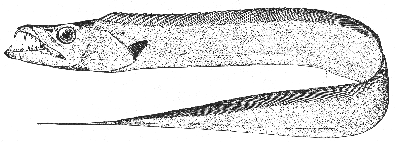Cutlassfish Trichiurus lepturus Linnaeus 1758
HAIRTAIL; SCABBARDFISH; SILVER EEL; RIBBANDFISH
[Jordan and Evermann, 1896-1900, p. 889.]

Figure 186.—Cutlassfish (Trichiurus lepturus), Florida. From Goode. Drawing by H. L. Todd.
Description—
The most striking characteristics of the cutlassfish are its band-like form tapering to a pointed whiplike tail without caudal fin; its single long dorsal fin (about 135 rays) originating close behind the eyes, about two-thirds as high at its midlength as the body is deep, and diminishing to nothing some distance in front of the tip of the tail; its long anal composed of very low detached spines pointing backward; and its long barbed fangs in the front of the mouth, four in the upper and two in the lower jaw. The depth of the body equals about one-thirteenth to one-fifteenth of its total length, about one-seventh to one-eighth of which is occupied by the head. The snout is pointed, the mouth gapes back to below the eye and the lower jaw projects beyond the upper. Each of the jaws is armed with 7 to 10 smaller teeth behind the fangs. The anal fin is reduced to a series of short inconspicuous spines, about 100 to 110 in number, without connecting fin membrane, running back from the vent nearly to the tip of the tail. The small pectorals are situated a little in advance of the rear corners of the gill covers. There are no ventral fins and the skin is scaleless.
Color—
Plain silvery all over. The dorsal fin is plain yellowish or dusky green in life, dark edged or speckled along the margin with black; the tips of the jaws dusky.
Size—
Maximum length about 5 feet.
General range—
All warm seas; abundant in the West Indies and Gulf of Mexico; not rare along the [page 351] South Atlantic coast of the United States, occasionally straying north as far as Massachusetts Bay.
Occurrence in the Gulf of Maine—
The cutlassfish is only an accidental straggler north of Cape Cod. One was taken at Wellfleet in the summer of 1845, and one in Salem Harbor also many years ago, and it is recorded from Lynn by Kendall.[48] There is no report of it farther north in the Gulf of Maine, or for Canadian waters.
[48] The Massachusetts Bay and Provincetown records listed by Kendall (Occ. Pap. Boston Soc. Nat. Hist., vol. 7, No. 8, 1908, p. 76) are based on the Wellfleet specimen. He also credits it to Monhegan I., Maine, quoting Storer as his authority, but Storer stated in his latest mention of the species that only two had come to his notice; the Wellfleet specimen just mentioned, and one taken at the head of Buzzards Bay.